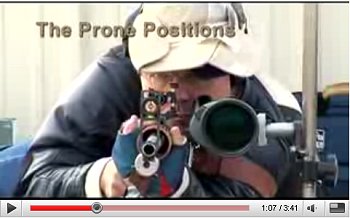Sightron 8-32×56 Scope Test, Part II
AccurateShooter.com has been testing one of the new Sightron SIII 8-32×56 target scopes. In Part One of our Sightron Test, Jason Baney reviewed the optical qualities and characteristics of the scope — what you see through the lens.


Sightron Test PART TWO — Mechanical Tracking
Now, in Part Two of our test, Jason took the scope to the range to test how well it tracks, and how repeatable the clicks are. Jason did a variety of tests, including a “box test” at 100 yards, and multi-cycle elevation tracking tests at both 100 yards and 300 yards.
In the box text, Jason zeroed his gun, a 6.5×47 Lapua, then put two shots in the lower left corner of a large sheet of paper. He then clicked up 72 clicks (18 MOA) and fired two more shots. Then he added 60 clicks (15 MOA) right, and fired two shots. Next he went back down 72 clicks (18 MOA) and fired two shots in the right corner. Finally he went back 60 clicks left (15 MOA), and fired two shots in the lower left.
Box test results were impressive. The last set of shots were virtually in the same place horizontally as the first two, just slightly over one bullet diameter below the “start” group. Jason noted: “The ‘last corner of the box’ vertical could easily be mirage, barrel heating, or my hold.” Jason noted that both the left and right vertical legs of the box, measured from group center to center, were exactly 19.8″. The top horizontal side of the box measured 16.375″ while the bottom horizontal was 16.25″. Jason notes: “The horizontal legs were within 0.125″. That difference could have easily been wind.”
Jason made 264 total clicks during the box test. His final two shots were just slightly below the first two — close enough that mirage could explain the difference. Jason concluded: “I think the Sightron showed excellent tracking. I noted that the vertical ‘side leg’ measurements were exactly the same. I didn’t end up in exactly the same spot, but it was really close. The slight shift in elevation could be caused by mirage or barrel heating.”
UP/DOWN Tracking Cycle Tests
To further test the vertical tracking repeatability, Jason shot a five-round group at 100 yards. Before EVERY shot he cranked in 120 clicks (30 MOA) of vertical, then cranked back down 120 clicks (30 MOA). As you can see from the target, the Sightron tracked beautifully. Though there is some horizontal (from wind), the total vertical spread for all five shots is about 0.1″, and that’s as tight (or tighter) than Jason’s rifle can normally shoot, as we explain below. Jason notes: “The group at 100 yards shows about 0.1″ vertical…can’t ask any better than that. So, the scope’s adjustments were obviously not adding any vertical component to the group.”

Test Gun: 6.5×47 Lapua, 123 Scenar, Reloder 15
Test Conditions: 100 yards, 90° F, 50% RH, 0-3 mph wind
Test done with 1/3 MOA Rifle
Jason conducted the test with a 6.5×47 rifle. This is a very accurate gun, and Jason is a great trigger-puller, but this is no rail gun. Repeatable group size for this rifle is typically mid-threes. The Sightron exhibited tracking repeatability inside the normal group vertical spread of this rifle (when no elevation clicks are made). We can conclude then, that the actual vertical tracking shift (after five 30 MOA up/30 MOA down cycles) is negligible.
 300-Yard UP/DOWN Tracking Test
300-Yard UP/DOWN Tracking Test
To supplement our findings at 100 yards, Jason repeated the 30 MOA up/30 MOA down cycle test with five (5) shots at 300 yards. He ended up with 5 shots with a total vertical of 1.5″ or 1/2 MOA. Again, given the limitations of the rifle and its typical vertical spread at 300 yards, this was very good. Note that three of the five shots went into about 1/2″ of vertical. Jason believes the shot low left was “driver error” or mirage. If that shot is excluded, the total vertical was 0.734″ or 0.234 MOA — which is about as tight as this gun can shoot at 300 yards. Jason concluded: “If you exclude the low left shot, which was probably me or mirage, we have a quarter-MOA vertical group. I’m not sure the gun can do better. In fact, 1/3 MOA is more typical. If scope tracking error was inducing vertical I would have expected the vertical spread to have been much larger. Here’s a situation where we can’t really overcome the gun (and shooter’s) inherent precision limits. I’ll give the Sightron a thumbs up here. If it was even two clicks off after all that cycling, the group would have shifted 1/2 MOA (about 1.5″) up or down, and that didn’t happen.”

Working the Turrets–Mechanical Feel
Jason said the turrets offer a good feel: “The effort needed to rotate the turrets is minimal, but the clicks are very smooth and positive. Overall, the feel is very good for both horizontal and vertical controls. The feel of the side-focus parallax is also good, and the side-focus did not display any lash or focus problems that we’ve observed on some other brands of optics.”














 If you shoot Service Rifle, High Power, or prone, you can benefit from watching this short sampler video. The full 2-disc DVD is available for $49.95 from
If you shoot Service Rifle, High Power, or prone, you can benefit from watching this short sampler video. The full 2-disc DVD is available for $49.95 from 




